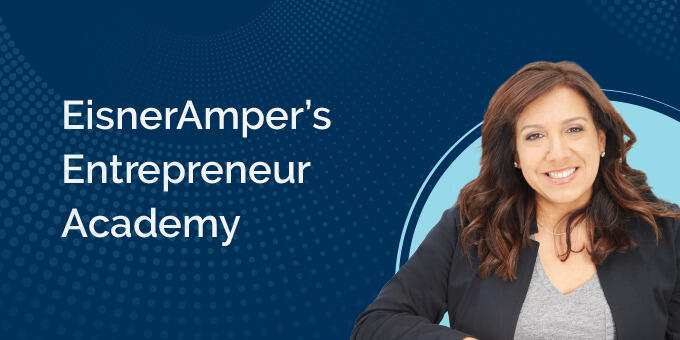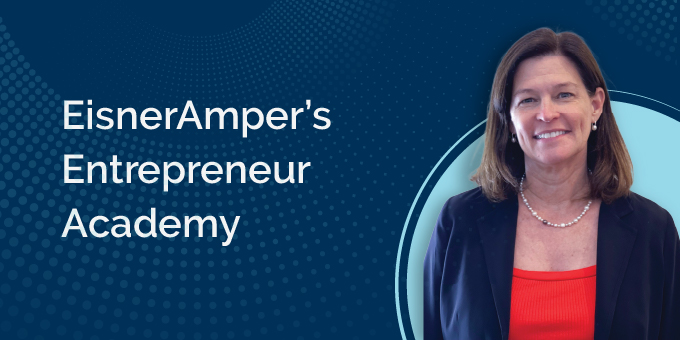Entrepreneur Academy
- Published
- Jan 5, 2022
- Topics
- Share
Entrepreneurs often obtain financing to fund their businesses; however, many start-ups overlook the costs incurred to obtain debt or equity. In this video, you’ll learn about “issuance costs” and how to properly account for them based on the type of funding that was raised.
Transcript
Janina Teoxon:
In EisnerAmper's Entrepreneur Academy series, we'll discuss debt and equity costs that technology and life science entrepreneurs should consider to fund their business, including which costs to track, how to mark the costs, and finally, how to account for the various costs. Startup and life science entities often raise debt and equity financing to fund their businesses, and raising debt or equity is always an exciting time for these entrepreneurs. However, I've noticed that many of my startup of technology and life science clients frequently overlook an important component in the financing, and that's the costs incurred by these entities to obtain debt or equity for what we call issuance costs, such as legal fees, printing costs, bankers' or underwriters' fees, and travel costs.
While these costs typically represent only a fraction of these financing proceeds, it is important that entities give attention to this, as there is a specific accounting guidance for these type of costs that they need to follow to properly account for them under US GAAP. Some of these guidance can be complex depending on the type of funding that was raised, so I have some helpful tips for you. Number one, track, all costs that were incurred as part of the financing transaction. You want to make sure that you have a complete list of the costs. Some startups find that a Microsoft Excel spreadsheet is efficient, while others utilize their accounting system like QuickBooks, and some others find that hiring an outside consultant is the best way to track an account for these costs.
Number two, identify or mark those costs that are incremental and direct to the financing. When you are doing this, the key thing to keep in mind is that these are the costs that otherwise would not be incurred. So, ask yourself, if the financing did not occur, would I have paid for this cost? If the answer is no, it is likely that the costs are incremental and direct to the financing, and hence are considered issuance costs. For example, if a SAAS founder determined that he or she would have paid for printing costs related to the financing, then it would be considered as issuance costs.
It is also possible that your answer to this question is a yes and no, meaning a portion of the cost of the cost you paid is directly related to the financing and the other portion is not. For example, a pharmaceutical company issued a syndicated loan with multiple lenders, and a portion of the fees paid lead creditor represents compensation for services associated with the issuance of the debt for the other participating lenders. These costs may qualify as issuance costs, so you want to mark these costs as well, since there may be an allocation that you need to do here and only account for the portion that is directly related to the financing as issuance costs. Take note that employee salaries, rent, and other period costs will have to be recognized as expenses as incurred.
Number three, now that you have a list of these issuance costs, you're ready to account for them properly. If these costs were incurred for a debt financing under ASC 835, these issuance are capitalized and presented as a direct deduction from the recognized liability on the balance sheet. Then, generally, debt issuance costs are advertised and recognized as additional interest expense over the life of the debt instrument using the effective interest method. If these costs were occurred for an equity financing, and the stock issued was classified as equity instruments, then those costs are accounted for as in reduction in the proceeds received from the sale of stock and are not advertised.
So, there you have it. That's how you account for these special costs related to the more traditional debt and equity financings. There are definitely situations when a financing is more complex. If you have any questions, feel free to start a conversation with us. We're here to help and to listen.
Transcribed by Rev.com
Entrepreneur Resource Hub
EisnerAmper’s Entrepreneur Academy “EA2” offers early-stage startups continuous learning opportunities—from fundraising to mitigating risk to growing their businesses.
What's on Your Mind?
Start a conversation with Janina
Receive the latest business insights, analysis, and perspectives from EisnerAmper professionals.



